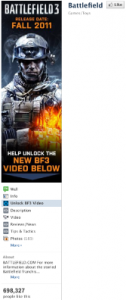Two marketing examples (both in the video game industry) crossed my space this week.
The first was something Simon Pulman brought to my attention: Electronic Arts’ “Community Challenge” to get 1 Million “Likes” on its Battlefield 3 Facebook page (see the details here). Basically, a hi-rez commercial will be released early if EA hits its target on Facebook.
The second came from Steve Peters, who tweeted about the disappointing end to Valve’s ARG for the new game, Portal 2 (more on the backlash here). In short, after playing through the ARG and expecting an early release of the game, players were hit with the following after completing the experience: if you want to play Portal 2 early, you have to buy more stuff from us first (or have already purchased certain games from a game pack sold by Valve).
It appears that the ARG players received at least one of the games from the game pack (“Potato Sack”), so they don’t have to buy one. But that’s not the point. The point here is that having played the ARG wasn’t sufficient to unlock the prize. Instead of getting the expected prize, players got another challenge they had to overcome.
Steve likens this kind of switch-and-bait tactic to the scene from “Christmas Story” where the boy finally gets his secret decoder ring so he can unlock the secret messages being transmitted at the end of the Little Orphan Annie radio show. To his disappointment, the first secret message the boy decodes is a commercial for a consumer product (the message is “drink more Ovaltine”).
While EA at least gets credit for a certain level of transparency and a higher degree of parity between what’s being asked of consumers (the risk/opportunity costs) and what’s being offered to them (the reward/payoff), neither of these examples inspires me to feel better about the companies behind them or more interested in buying their games.
These two examples span the spectrum of engagement for customers.
How hard is it to Like a Facebook page? Not hard at all, but that also means I have zero investment in the action of liking that page. Furthermore, I may or may not see the benefit of even that small action, since Battlefield 3’s Facebook page may not hit the 1 Million target (as of now, it’s received about 700,000 likes). Low investment, low reward for the consumer = low engagement with the product/company.
At the other end is Valve’s ARG experience, which required far more investment on the part of consumers, and given the clues listed in the experience, there was a reasonable expectation the game might be released early (or early to the ARG players) in exchange for their efforts and time. High investment, high reward = high engagement with the product/company.
Clearly, companies want their customers highly engaged with them (or at least their products). But the Valve ARG demonstrates the dangers of reaching for high engagement. Experience parity is shaped by the expectations, the transparency, and the clarity of the experience.
Remember, there’s an opportunity cost for consumers to spend their time and money on a particular product. Instead of playing a company’s ARG or video game, they could be having dinner at a restaurant, watching a movie, or sleeping. If a company asks a consumer to forego EVERY other opportunity in order to engage with it or its products, it should:
- set expectations appropriately
- transparently communicate the risk/reward
- clearly communicate what is being asked
If, as in the ARG example, full transparency would dilute the experience, then the company should plan to over-deliver and clearly communicate to avoid a disconnect in expectations and the experience.
I’m less offended by EA, as their experience hit all of the points above. It’s uninspired, but it’s honest. And honesty goes a long way.

